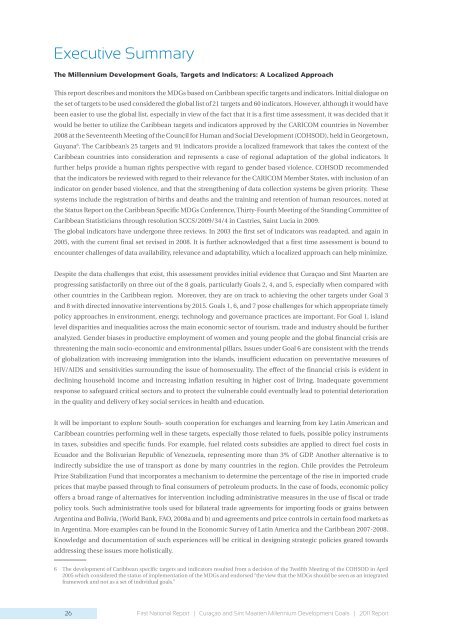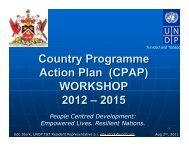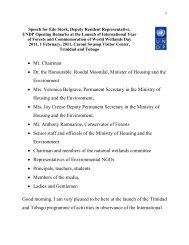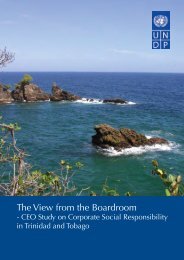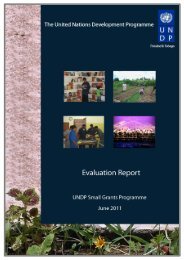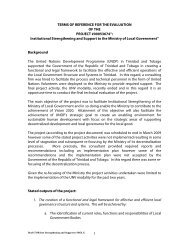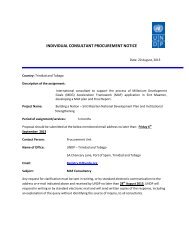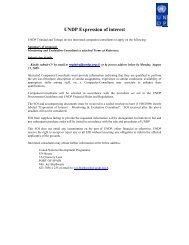Curaçao & Sint Maarten - UNDP Trinidad and Tobago
Curaçao & Sint Maarten - UNDP Trinidad and Tobago
Curaçao & Sint Maarten - UNDP Trinidad and Tobago
Create successful ePaper yourself
Turn your PDF publications into a flip-book with our unique Google optimized e-Paper software.
Executive Summary<br />
The Millennium Development Goals, Targets <strong>and</strong> Indicators: A Localized Approach<br />
This report describes <strong>and</strong> monitors the MDGs based on Caribbean specific targets <strong>and</strong> indicators. Initial dialogue on<br />
the set of targets to be used considered the global list of 21 targets <strong>and</strong> 60 indicators. However, although it would have<br />
been easier to use the global list, especially in view of the fact that it is a first time assessment, it was decided that it<br />
would be better to utilize the Caribbean targets <strong>and</strong> indicators approved by the CARICOM countries in November<br />
2008 at the Seventeenth Meeting of the Council for Human <strong>and</strong> Social Development (COHSOD), held in Georgetown,<br />
Guyana6 . The Caribbean’s 25 targets <strong>and</strong> 91 indicators provide a localized framework that takes the context of the<br />
Caribbean countries into consideration <strong>and</strong> represents a case of regional adaptation of the global indicators. It<br />
further helps provide a human rights perspective with regard to gender based violence. COHSOD recommended<br />
that the indicators be reviewed with regard to their relevance for the CARICOM Member States, with inclusion of an<br />
indicator on gender based violence, <strong>and</strong> that the strengthening of data collection systems be given priority. These<br />
systems include the registration of births <strong>and</strong> deaths <strong>and</strong> the training <strong>and</strong> retention of human resources, noted at<br />
the Status Report on the Caribbean Specific MDGs Conference, Thirty-Fourth Meeting of the St<strong>and</strong>ing Committee of<br />
Caribbean Statisticians through resolution SCCS/2009/34/4 in Castries, Saint Lucia in 2009.<br />
The global indicators have undergone three reviews. In 2003 the first set of indicators was readapted, <strong>and</strong> again in<br />
2005, with the current final set revised in 2008. It is further acknowledged that a first time assessment is bound to<br />
encounter challenges of data availability, relevance <strong>and</strong> adaptability, which a localized approach can help minimize.<br />
Despite the data challenges that exist, this assessment provides initial evidence that <strong>Curaçao</strong> <strong>and</strong> <strong>Sint</strong> <strong>Maarten</strong> are<br />
progressing satisfactorily on three out of the 8 goals, particularly Goals 2, 4, <strong>and</strong> 5, especially when compared with<br />
other countries in the Caribbean region. Moreover, they are on track to achieving the other targets under Goal 3<br />
<strong>and</strong> 8 with directed innovative interventions by 2015. Goals 1, 6, <strong>and</strong> 7 pose challenges for which appropriate timely<br />
policy approaches in environment, energy, technology <strong>and</strong> governance practices are important. For Goal 1, isl<strong>and</strong><br />
level disparities <strong>and</strong> inequalities across the main economic sector of tourism, trade <strong>and</strong> industry should be further<br />
analyzed. Gender biases in productive employment of women <strong>and</strong> young people <strong>and</strong> the global financial crisis are<br />
threatening the main socio-economic <strong>and</strong> environmental pillars. Issues under Goal 6 are consistent with the trends<br />
of globalization with increasing immigration into the isl<strong>and</strong>s, insufficient education on preventative measures of<br />
HIV/AIDS <strong>and</strong> sensitivities surrounding the issue of homosexuality. The effect of the financial crisis is evident in<br />
declining household income <strong>and</strong> increasing inflation resulting in higher cost of living. Inadequate government<br />
response to safeguard critical sectors <strong>and</strong> to protect the vulnerable could eventually lead to potential deterioration<br />
in the quality <strong>and</strong> delivery of key social services in health <strong>and</strong> education.<br />
It will be important to explore South- south cooperation for exchanges <strong>and</strong> learning from key Latin American <strong>and</strong><br />
Caribbean countries performing well in these targets, especially those related to fuels, possible policy instruments<br />
in taxes, subsidies <strong>and</strong> specific funds. For example, fuel related costs subsidies are applied to direct fuel costs in<br />
Ecuador <strong>and</strong> the Bolivarian Republic of Venezuela, representing more than 3% of GDP. Another alternative is to<br />
indirectly subsidize the use of transport as done by many countries in the region. Chile provides the Petroleum<br />
Prize Stabilization Fund that incorporates a mechanism to determine the percentage of the rise in imported crude<br />
prices that maybe passed through to final consumers of petroleum products. In the case of foods, economic policy<br />
offers a broad range of alternatives for intervention including administrative measures in the use of fiscal or trade<br />
policy tools. Such administrative tools used for bilateral trade agreements for importing foods or grains between<br />
Argentina <strong>and</strong> Bolivia, (World Bank, FAO, 2008a <strong>and</strong> b) <strong>and</strong> agreements <strong>and</strong> price controls in certain food markets as<br />
in Argentina. More examples can be found in the Economic Survey of Latin America <strong>and</strong> the Caribbean 2007-2008.<br />
Knowledge <strong>and</strong> documentation of such experiences will be critical in designing strategic policies geared towards<br />
addressing these issues more holistically.<br />
6 The development of Caribbean specific targets <strong>and</strong> indicators resulted from a decision of the Twelfth Meeting of the COHSOD in April<br />
2005 which considered the status of implementation of the MDGs <strong>and</strong> endorsed “the view that the MDGs should be seen as an integrated<br />
framework <strong>and</strong> not as a set of individual goals.”<br />
26 First National Report | <strong>Curaçao</strong> <strong>and</strong> <strong>Sint</strong> <strong>Maarten</strong> Millennium Development Goals | 2011 Report


